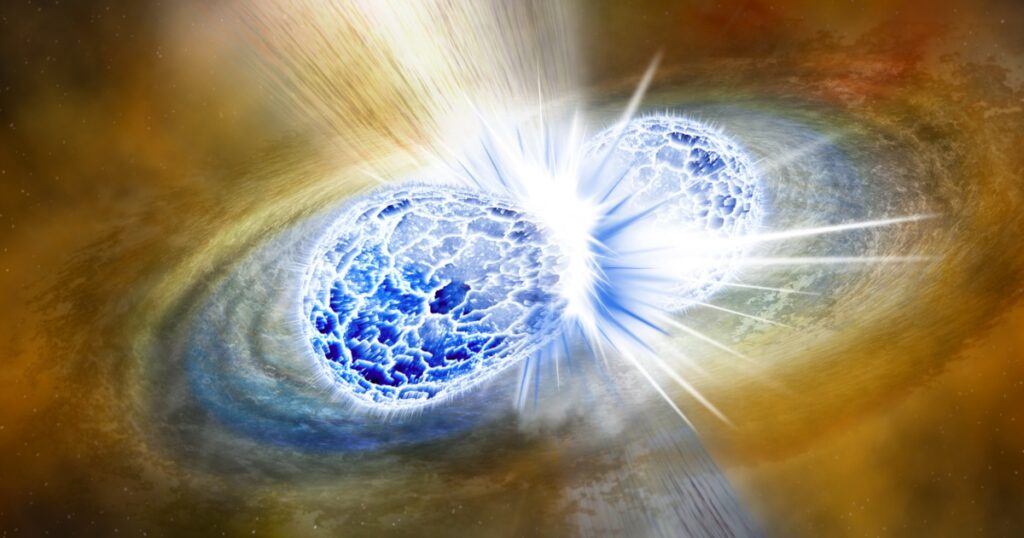When two neutron stars collide, it’s a cosmic spectacle unlike any other. These incredibly dense objects, the collapsed cores of massive stars, pack an unimaginable amount of mass and energy into a relatively tiny space. Their collision unleashes a series of dramatic events and results in a massive neutron star or a black hole.

What happens When Two Neutron Stars Collide?
A Cataclysmic Impact:
The collision of two neutron stars is a violent head-on smashup. The immense gravity of each neutron star pulls and distorts the other, leading to a catastrophic collision that releases a tremendous burst of energy in various forms:
Gravitational Waves: A significant portion of the energy is released as gravitational waves, ripples in the fabric of spacetime predicted by Einstein’s theory of relativity. Detecting these waves provides valuable insights into the nature of neutron stars and the violent events within the universe.
Gamma-Ray Burst: The collision also triggers a powerful gamma-ray burst, the most luminous explosion in the known universe. This burst of high-energy radiation can briefly outshine entire galaxies and can be detected from billions of light-years away.
A Remnant is Born:
The fate of the collision debris depends on the combined mass of the neutron stars. Here are the two main possibilities:
A New Black Hole: If the combined mass of the neutron stars exceeds a certain limit, the intense gravity overwhelms the outward pressure, leading to the collapse of the debris into a black hole. This newly formed black hole may be surrounded by a swirling disk of hot, leftover material.
A Massive Neutron Star: If the combined mass of neutron stars falls below the black hole threshold, the leftover material can be compressed further, forming a single, even more massive neutron star. This behemoth would be a record-breaker in terms of density and rotation.
A Heavy Metal Factory:
The immense heat and pressure generated during the collision can forge a remarkable variety of heavy elements, like gold, platinum, and uranium, from lighter elements. These elements are then ejected into the surrounding space, enriching the interstellar medium and potentially contributing to the formation of rocky planets and life-supporting molecules in future generations of stars.
The First Confirmed Neutron Star Merger GW170817 Wave:
On August 17, 2017, astronomers made a groundbreaking discovery. The LIGO/Virgo collaboration, a network of gravitational wave detectors, picked up a signal named GW170817. This signal wasn’t from a black hole collision, as previously observed, but originated from the long-theorized merger of two neutron stars in a distant galaxy named NGC 4993. This galaxy is located in the constellation Hydra, which is visible from the southern hemisphere.
The distance to NGC 4993, and hence the location of the neutron star merger, is a staggering 130 million light-years from Earth. This immense distance highlights the incredible sensitivity of our gravitational wave detectors and the vast scale of the universe we inhabit.

NGC 4993 is an elliptical galaxy located in the constellation Hydra. On August 17, 2017, the LIGO/Virgo team discovered GW170817, a gravitational wave linked to the merging of two neutron stars in NGC 4993. A brief (approximately two-second-long) gamma-ray burst, GRB 170817A, was identified 1.7 seconds after the GW merger signal, and an observational event involving visible light, SSS17a, was first spotted 11 hours after GW170817.
The co-occurrence of GW170817 with GRB 170817A in both space and time strongly implies that neutron star mergers create short gamma-ray bursts. The subsequent detection of Swope Supernova Survey event 2017a (SSS17a) in the area where GW170817 and GRB 170817A were known to have occurred and its having the expected characteristics of a kilonova, strongly imply that neutron star mergers are responsible for kilonovae as well.
“Systematic samples of tidal disruption events” indicated that the Zwicky Transient Facility started to monitor neutron star occurrences using gravitational wave observations in February 2018. Later that year, scientists revealed that GRB 150101B, a 2015-detected gamma-ray burst event, could be closely connected to GW170817 and linked to the merging of two neutron stars.
The two separate events may both be the result of neutron star mergers and both may be kilonovas, which may be more common in the universe than previously thought, according to the researchers, who note that the similarities between the two events are “striking” in terms of gamma-ray, optical, and x-ray emissions as well as the nature of the associated host galaxies.
Additionally, in October 2018, researchers unveiled a novel method for calculating the Hubble constant, which sets the universe’s rate of expansion, using data from gravitational wave occurrences, particularly those involving the merging of neutron stars like GW170817. There is a about 10% discrepancy between the two previous approaches to get the Hubble constant, one based on redshifts and the other on the cosmic distance ladder. A different kind of standard candle, kilonovae, might help to resolve this discrepancy, known as the Hubble tension.
The gravitational wave observatories LIGO and Virgo reported in April 2019 that they have detected a candidate event, which is a merger of two neutron stars with a probability of 99.94%. A lot of follow-up observations were made, but no electromagnetic parallel could be found.
The kilonova GRB 230307A was seen in 2023, and probable observations of its tellurium and lanthanide element spectra were included in the publication.
Importance of Neutron Stars Collisions:
Neutron star collisions offer astronomers a unique window into the nature of these exotic objects and the extreme physics at play under such incredible pressure and density. Studying these events helps us understand the behavior of matter under these conditions and refine our models of stellar evolution and the violent processes that shape the universe.
Conclusion:
Overall, the collision of two neutron stars is a violent yet fascinating cosmic event. It’s a testament to the power of gravity, the creation of rare elements, and a valuable source of information about the universe‘s most extreme objects.